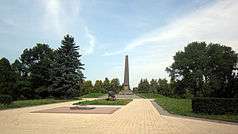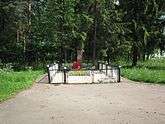Maly Trostenets extermination camp

The Trostinets extermination camp,[1] also known as Maly Trostinets,[2] Maly Trastsianiets and Trascianec (see alternative spellings), was a World War II Nazi German death camp located near the village of Maly Trostinets (Малы Трасцянец, "Little Trostinets") on the outskirts of Minsk in Reichskommissariat Ostland. It operated between July 1942 and October 1943, by which time, virtually all Jews remaining in Minsk had been murdered and buried there.[1][2]
History
Originally built in the summer of 1941 on the site of a Soviet kolkhoz, a collective farm 200 hectares (490 acres) in size, Trostinets was set up by Nazi Germany as a concentration camp with no fixed killing facilities, for the Soviet prisoners of war who had been captured during Operation Barbarossa launched against the Soviet Union on 22 June 1941.[3]
The camp became a Vernichtungslager (extermination camp) on 10 May 1942 when the first consignment of Jews was brought in under the guise of "resettlement". Jews from Austria, Germany and the Czech Republic were murdered there. The Holocaust transports organized by the SS were sent from Berlin, Hanover, Dortmund, Münster, Düsseldorf, Cologne, Frankfurt am Main, Kassel, Stuttgart, Nuremberg, Munich, Breslau, Königsberg, Vienna, Prague, Brünn, and Theresienstadt.[4] In most cases, the Jews were killed immediately upon arrival. They were trucked from the train stop to the nearby killing grounds at Blagovshchina (Благовщина) and Shashkovka (Шашковка) forests and shot in the back of the neck.
| Part of a series on | ||||||||||
| The Holocaust | ||||||||||
|---|---|---|---|---|---|---|---|---|---|---|
 | ||||||||||
|
||||||||||
|
Atrocities |
||||||||||
|
Camps
|
||||||||||
|
Remembrance |
||||||||||
The primary purpose of the camp was the killing of Jewish prisoners of the Minsk Ghetto and the surrounding area.[4] Firing squad was the chief execution method. Mobile gas chambers deployed at Trostinets performed a subsidiary if not insignificant function in the killing process. These were called "gas vans". Baltic German SS-Scharführer Heinrich Eiche was the camp administrator.[5]
On 28 June 1944, as the Red Army approached the region, the Germans blew up the camp as part of Sonderaktion 1005, an operation to destroy evidence of genocide. But the Soviets are said to have discovered 34 grave-pits, some of them measuring as much as 50 meters (160 ft) in length and three to four meters (9.8–13 ft) in depth, located in the Blagovshchina Forest some 500 meters (1,600 ft) from the Minsk–Mogilev highway according to the special report prepared by the Soviet Extraordinary State Commission in the 1940s. Only a few Jewish prisoners survived Maly Trostenets.[2] They were liberated by the Red Army and gave first witness testimonies about its existence on 7 July 1944.[2]
According to modern historians of the Holocaust, original estimates of the number of people killed at Trostinets were greatly exaggerated by functionaries of the Soviet State Commission; ranging from 200,000 to more than half a million. Yad Vashem in Jerusalem and other researchers estimate the true number of victims at 60,000–65,000 Jews.[2][4]
Perpetrators
Only a few perpetrators of the Holocaust from Trostinets were brought to justice after the war. Among them was Eduard Strauch, who died in a Belgian prison in 1955. In 1968 a court in Hamburg sentenced to life imprisonment three low-ranking SS men – Rottenführer Otto Erich Drews, Revieroberleutnant Otto Hugo Goldapp, and Hauptsturmführer Max Hermann Richard Krahner – German overseers of the Jewish Sonderkommando 1005 who were recognized as guilty of murdering the laborers forced to cover up the traces of the crimes in 1943.[4] Several people were also convicted during trials in West Germany and the USSR, although they were not at Maly Trostenets, but for the crimes committed in the wider area of Minsk.[6]
Heinrich Seetzen committed suicide in a British POW camp. Heinrich Eiche fled to Argentina after the war and all trace of him was lost. Gerhard Maywald settled after the war in West Germany. In 1970, the public prosecutor's office in Koblenz ended an investigation against him "because of the absence of sufficient evidence of guilt". On 4 August 1977 Maywald was sentenced to four years' imprisonment for murder and complicity involving 8,000 Jews in Latvia.[7]
Currently nothing remains of the actual camp other than a row of poplars planted by the inmates as part of the natural border of the camp. The site is scheduled for reconstruction and development.
Camp's name
In Belarusian the name is Малы Трасцянец (pronounced [maˈlɨ trasʲtsʲaˈnʲets]), transliterated as Maly Tras’tsyanyets; in Russian it is Малый Тростенец. Alternative romanizations and the placename’s German variants include Maly Trostinets, Maly Trostinez, Maly Trostenez, Maly Trostinec and Klein Trostenez – literally, "Little" Tras’tsyanyets) as opposed to the neighboring locality named Вялікі Трасцянец or "Large" Tras’tsyanyets).
Known victims
The names of 10,000 Austrian Jews murdered in Maly Trostinec are gathered in a book "Maly Trostinec - Das Totenbuch - Den Toten ihre Namen geben". Compiled and edited by Waltraud Barton (Hrsg.)Vienna. Edition Ausblick
- Cora Berliner (most likely)
- Grete Forst
- Vincent Hadleŭski [Wincenty Godlewski], Roman Catholic priest and Belarusian nationalist resistance fighter (b. 1888), arrested in Minsk on 24 December 1942 and shot at Trostenets the same day.[8]
- Margarete Hilferding (in transit to the camp from Terezín)
- Norbert Jokl (debated)
Commemoration
A memorial built at the site of the camp attracts thousands of visitors annually, especially after travel restrictions eased with the dissolution of the Soviet Union.
 Memorial sign on the place of main massacres
Memorial sign on the place of main massacres The sign on the obelisk, in Belarusian, quotes the widely disputed number of 201,500 victims.[n 1]
The sign on the obelisk, in Belarusian, quotes the widely disputed number of 201,500 victims.[n 1]_01.jpg) The plate of the planned memorial complex (see image description for its text)
The plate of the planned memorial complex (see image description for its text)_12.jpg) Memorial complex, built in 2015
Memorial complex, built in 2015
See also
- List of Nazi concentration camps
- Kaiser Wilhelm Institute of Anthropology, Human Heredity, and Eugenics
- Max Planck Society Archive
Notes
- ↑ The number of casualties is disputed by historians (see History section above).
References
- 1 2 Dr. Leonid Smilovitsky (1999). "Ilya Ehrenburg on the Holocaust in Belarus: Unknown Testimony". Vol. 29, No. 1–2, Summer–Winter. East European Jewish Affairs. pp. 61–74. Retrieved 1 September 2013.
Ilya Ehrenburg's Black Book cites the official data that in all, 206,500 people were murdered at Trostenets, of whom 150,000 were killed at the Blagovshchina Forest between September 1941 and October 1943, and another 50,000 at the Shashkovka Forest between October 1943 and June 1944.
- 1 2 3 4 5 Yad Vashem (2013). "Maly Trostinets" (PDF file, direct download, 19.5 KB). Shoah Resource Center, The International School for Holocaust Studies. Retrieved 1 September 2013.
- ↑ ARC (28 May 2006). "Maly Trostinec". DeathCamps.org. Archived from the original (Internet Archive) on July 1, 2014. Retrieved 29 January 2015.
- 1 2 3 4 Encyclopedia of the Holocaust (2 April 2006). ""Sonderkommando 1005" trials: Hamburg, 1968". Aktion 1005. ARC. Archived from the original (Internet Archive) on July 23, 2014. Retrieved 29 January 2015.
- ↑ Paul Kohl (2003). Das Vernichtungslager Trostenez: Augenzeugenberichte und Dokumente. Internationales Bildungs- und Begegnungswerk IBB. pp. 102–111.
- ↑ Der Spiegel (30 September 1968). "Wolkenhöhe". Prozesse / Sonderkommando 1005. Der Spiegel 40/1968. Retrieved 29 January 2015.
- ↑ Einsatzgruppen Trials Axis History Forum.
- ↑ Syargyey Yorsh (b. 1972), Rytsar Svabody... [Рыцар Свабоды: Ксёндз Вінцэнт Гадлеўскі як ідэоляг і арганізатар беларускага нацыянальнага антынацыскага Супраціву; =Champion of Liberty: The Reverend Vincent Hadleŭski as the Ideologue and Organizer of Belarusian National Anti‑Fascist Resistance], Minsk, Belaruski Rėzystans, 2004 – a monograph on his life; Library of Congress control No. 2004454542: call No. not available
- The Invasion of the Soviet Union and the Beginnings of Mass Murder on the Yad Vashem website.
- Marking 70 Years to Operation Barbarossa on the Yad Vashem website.
Further reading
- Ernst Klee and Willi Dressen, with Volker Riess, “Gott mit uns”: Der deutsche Vernichtungskrieg im Osten, 1939–1945 (Frankfurt am Main, S. Fischer, 1989).
- Shmuel Spector, ‘Aktion 1005 – Effacing the Murder of Millions’, Holocaust Genocide Studies (Oxford), vol. 5 (1990), pp. 157–173 [on the Nazi attempts to obliterate the evidence of mass murder at Maly-Trostinets (the spelling of the place-name adopted by Spector)]
- Paul Kohl, Der Krieg der deutschen Wehrmacht und der Polizei, 1941–1944: sowjetische Überlebende berichten, with an essay by Wolfram Wette (Frankfurt am Main, Fischer-Taschenbuch-Verlag, 1995) [includes a photo of the camp].
- Christian Gerlach, Kalkulierte Morde: Die deutsche Wirtschafts- und Vernichtungspolitik in Weißrußland 1941 bis 1944 (Hamburg, Hamburger Edition, 1999).
- Hans Safrian, ‘Expediting Expropriation and Expulsion: The Impact of the “Vienna Model” on Anti-Jewish Policies in Nazi Germany, 1938’, Holocaust Genocide Studies (Oxford), vol. 14 (2000), pp. 390–414 [mentions deportations from Austria to Maly Trostinets (the spelling adopted by Safrian)].
- [Ė.G. Ioffe, G.D. Knat’ko, V.D. Selemenev, comps.], Kholokost v Belarusi, 1941–1944: dokumenty i materially [Holocaust in Belarus, 1941–1944: Documents and Materials] (Minsk, NARB [National Archives of the Republic of Belarus], 2002).
- [V.I. Adamushko, et al., comps.], Лагерь смерти “Тростенец”: Документы и материалы [The Trostenets Death Camp: Documents and Materials] (Minsk, NARB [National Archives of the Republic of Belarus], 2003) [includes some 25 pages of photographic evidence; ISBN 985-6372-30-5].
- [K.I. Kozak, et al., eds.], Henatsyd u druhoĭ susvetnaĭ vaĭne: Prablemy dasledavanniya u pamiyats akhviyar Trastsiyantsa... (Minsk, Vydavetski tsentr BDU, 2003) [proceedings of the international conference on the subject of the ‘Todeslager Trostenez’ (so spelt in the book) held in Minsk between April 25 and 27, 2002].
- S.V. Zhumar’ & R.A. Chernoglazova, comps., Trostenets (Minsk, GK ‘Poligrafoformlenie’, 2003) [published under the auspices of the Belarus government; includes summaries in English and German; Library of Congress call No. D805.5.M358 T76 2003].
- Igor’ Kuznyetsov, ‘В поисках правды, или Трагедия Тростенца: до и после’ [In Search of Truth; or, The Tragedy of Trostenets: Before and After], Belorusskaya delovaya gazeta [Belarus Business News] (Minsk), No. 1416 (April 2, 2004) [makes the interesting claim, supported in part by references to published sources (e.g., A.I. Zalesskiĭ, I.V. Stalin i kovarstvo ego politicheskikh protivnikov, 2 vols., Minsk, 1999–2002), that the Blagovshchina Forest had previously been the execution ground of choice for the local branches of the Soviet NKVD].
- [Petr Krymsky], ‘Тростенец – белорусский “Oсвенцим”’ [Trostenets – Belarusian ‘Auschwitz’], Rossiĭskie vesti [Russian News] (Moscow), No. 16 (1771), May 11–18, 2005 [seems to take issue with the claims made in the preceding article; includes two contemporary photographs of Soviet excavations].
- [Z.R. Iofe, et al., eds.], Laher smertsi Tras’tsyanyets, 1941–1944 hh.: pamiyatsi akhviyar natsyzma ŭ Belarusi [The Tras’tsyanyets Death Camp, 1941–1944: In Memory of the Victims of Nazism in Belarus] (Minsk, Histarychnaiya maĭstėrniya, 2005).
Coordinates: 53°51′44″N 27°42′19″E / 53.86222°N 27.70528°E